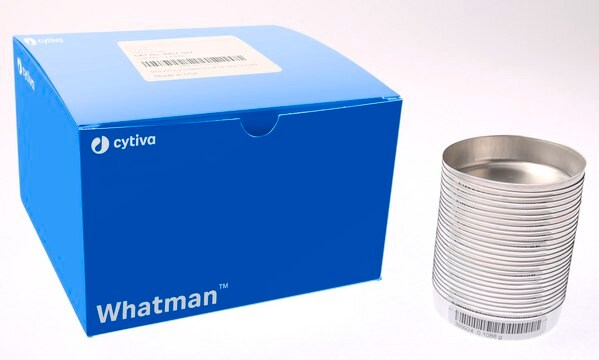WHA5401090E
Whatman® Moisture Test Paper
diam. (90 mm), pack of 100 ea
Sign Into View Organizational & Contract Pricing
All Photos(2)
About This Item
UNSPSC Code:
40161507
NACRES:
NB.24
Recommended Products
material
borosilicate glass
packaging
pack of 100 ea
manufacturer/tradename
Cytiva
diam.
(90 mm)
Related Categories
General description
Moisture test paper for use when drying samples during moisture assessment.
Legal Information
Whatman is a registered trademark of Cytiva
Certificates of Analysis (COA)
Search for Certificates of Analysis (COA) by entering the products Lot/Batch Number. Lot and Batch Numbers can be found on a product’s label following the words ‘Lot’ or ‘Batch’.
Already Own This Product?
Find documentation for the products that you have recently purchased in the Document Library.
Neil Cockburn et al.
Nuclear medicine communications, 41(10), 1100-1105 (2020-07-23)
Oxygen-15 (O; t½ = 122.4 s) has been used for nuclear imaging experiments since the beginning of the field. With the advent of simultaneous hybrid PET/MR technology, [O]water has seen a resurgence and remains the gold standard method for quantitative blood
Qiaoling Yang et al.
Journal of ethnopharmacology, 255, 112556-112556 (2020-01-14)
Sweroside, an iridoid derived from Traditional Chinese Medicine, is an active component in Swertia pseudochinensis Hara. Swertia pseudochinensis Hara is first recorded in "Inner Mongolia Chinese Herb Medicine"and is considered as a folk medicine for treating hepatitis in northern China.
Matthew S Binder et al.
Behavioural brain research, 378, 112189-112189 (2019-10-07)
The NS-Pten knockout (KO) mouse exhibits hyperactivity of the mammalian target of rapamycin (mTOR) and is a model of autism spectrum disorder (ASD). ASD presents with marked deficits in communication which can be elucidated by investigating their counterpart in mice
Wei Zhang et al.
Sensors (Basel, Switzerland), 21(4) (2021-02-11)
In the process of collaborative operation, the unloading automation of the forage harvester is of great significance to improve harvesting efficiency and reduce labor intensity. However, non-standard transport trucks and unstructured field environments make it extremely difficult to identify and
Ahmed Ibrahim et al.
Journal of equine veterinary science, 97, 103344-103344 (2021-01-23)
The exact contribution of the orbital lacrimal gland (OLG) is unknown and is still a subject of debate and inconsistency in literature. Currently, there are no detailed studies addressing the influence of the OLG removal on tear production in equines.
Our team of scientists has experience in all areas of research including Life Science, Material Science, Chemical Synthesis, Chromatography, Analytical and many others.
Contact Technical Service




